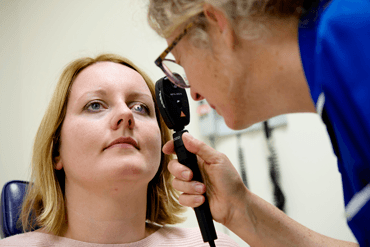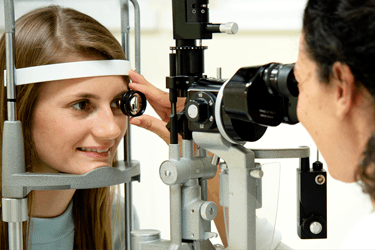Tests and scans
An eye examination is a test where the specialist eye doctor (ophthalmologist) examines your eyes. They use a few different instruments to look at the eye internally and externally.
You may have an eye examination to look at the different structures of your eye. This helps the doctor to check for changes or abnormalities.
You usually don’t have to prepare for an eye test. Your hospital letter will tell you if there is anything you have to do.
You may have drops into your eyes before the examination. These enlarge the pupils to make it easier for the eye specialist to look in your eyes.
The eye drops might sting a bit when they first go in. They can cause blurred vision, and your eyesight may be blurry for a few hours, so you shouldn't drive yourself home. It might be helpful to take a relative or friend to your appointment. Dilated pupils can also make your eyes more sensitive to sunlight. So bring a pair of sunglasses with you.
The eye specialist will examine your eyes with a few different instruments. They look at the different structures of your eye to check for changes or abnormalities.
Your eye specialist might examine your eyes using a hand held device called an ophthalmoscope. This shines a light into the back of your eye. It usually takes a few minutes.

Eye examination using an ophthalmoscope
You may also have your eyes examined with an instrument called a slit lamp. This is larger than the ophthalmoscope and sits on a table. This instrument has a bright light and powerful microscope so the doctor can look at the front and back of your eye in detail.
This test takes about 30 minutes. You usually have drops put into your eye to enlarge the pupils. You sit on a chair in front of the slit lamp and rest your chin and forehead on the instrument. This keeps your head steady during the test, so the doctor can have a clear view of the different parts inside your eyes. You often have photographs or digital images taken of your eyes. These are kept in your medical records.

Eye examination using a slit lamp
You can usually go home straight after your test.
An eye examination is a safe procedure, but there are a few things to remember:
Your eyes may sting slightly from the eye drops to dilate your pupils.
You may have blurred vision for 4 to 6 hours after you have had the eye drops.
You may not be able to drive safely, so avoid doing so until your usual (normal) vision has returned.
You may not be able to do tasks such as computer work or reading for a few hours.
Your eyes can be sensitive to light for a short time afterwards. So bring a pair of sunglasses to your appointment to wear.
If you normally wear contact lenses, you may be unable to put your lenses back in immediately. It may help to bring your glasses (spectacles), to use until you can put your lenses back in. This is usually around 30 minutes after this test.
You may have to wait to get the results.
Waiting for results can make you anxious. Ask your doctor or nurse how long it will take to get them. Contact the doctor who arranged the test if you haven’t heard anything after a couple of weeks.
You might have contact details for a specialist nurse and you can contact them for information if you need to. It may help to talk to a close friend or relative about how you feel.
Last reviewed: 26 Nov 2024
Next review due: 26 Nov 2027
You usually have a number of tests to diagnose eye cancer. The tests you might have include an eye examination and a test to look at the blood vessels in your eye (fluorescein angiogram).
Your treatment depends on several factors. These include what type of eye cancer you have, how big it is and whether it has spread (the stage). It also depends on your general health.
Your GP or optometrist will ask you about your symptoms, and they might examine you. They may arrange tests or a referral to a specialist.
Eye cancer symptoms are not always obvious. It is most likely to be picked up during a routine eye test.
Eye cancer includes different types of cancer. The type of eye cancer you have depends on the type of cell it starts in. There are different parts of the eye, and some of these are more likely to get cancer than others.
Find out about tests to diagnose cancer and monitor it during and after treatment, including what each test can show, how you have it and how to prepare.

About Cancer generously supported by Dangoor Education since 2010. Learn more about Dangoor Education
What to ask your doctor about clinical trials.
Meet and chat to other cancer people affected by cancer.
Questions about cancer? Call freephone 0808 800 40 40 from 9 to 5 - Monday to Friday. Alternatively, you can email us.